Attached files
| file | filename |
|---|---|
| EX-99.1 - EX-99.1 - Inhibrx, Inc. | exhibit991pressrelease1520.htm |
| 8-K - 8-K - Inhibrx, Inc. | ox40pr152021.htm |

Outcomes Focused Innovation Driven January 2021

2 This presentation contains forward-looking statements. In some cases, you can identify forward-looking statements by the words “will,” “expect,” “intend,” “plan,” “objective,” “believe,” “estimate,” “potential,” “continue” and “ongoing,” or the negative of these terms, or other comparable terminology intended to identify statements about the future. These statements are based on management’s current beliefs and expectations. These statements include but are not limited to statements regarding Inhibrx, Inc.’s (the “Company”) business strategy, the Company’s plans to develop and commercialize its product candidates, the safety and efficacy of the Company’s product candidates, the Company’s plans and expected timing with respect to clinical trials and regulatory filings and approvals, and the size and growth potential of the markets for the Company’s product candidates. These statements involve substantial known and unknown risks, uncertainties and other factors that may cause the Company’s actual results, levels of activity, performance or achievements to be materially different from the information expressed or implied by these forward- looking statements. Additional information regarding the Company’s risks and uncertainties are described in its Registration Statement on Form S-1 filed with the Securities and Exchange Commission (“SEC”) on August 12, 2020 in the section titled “Risk Factors,” and in other filings the Company may make with the SEC from time to time. Presentation disclaimer The Company may not actually achieve the plans, intentions or expectations disclosed in its forward-looking statements, and you should not place undue reliance on the Company’s forward-looking statements. Actual results or events could differ materially from the plans, intentions and expectations disclosed in the forward-looking statements the Company makes. The forward-looking statements in this presentation represent the Company’s views as of the date of this presentation. The Company anticipates that subsequent events and developments will cause its views to change. However, while the Company may elect to update these forward-looking statements at some point in the future, the Company has no current intention of doing so except to the extent required by applicable law. You should, therefore, not rely on these forward-looking statements as representing the Company’s views as of any date subsequent to the date of this presentation. The investigational product candidates discussed in this presentation have not been approved or licensed by the U.S. Food and Drug Administration or by any other regulatory authority, and they are not commercially available in any market. This presentation also contains estimates and other statistical data made by independent parties and by the Company relating to market size and growth and other data about its industry. This data involves a number of assumptions and limitations, and you are cautioned not to give undue weight to such estimates. In addition, projections, assumptions, and estimates of the Company’s future performance and the future performance of the markets in which it operates are necessarily subject to a high degree of uncertainty and risk. This presentation shall not constitute an offer to sell or the solicitation of an offer to buy securities.

3 Key investment highlights Proprietary single domain antibody (sdAb) platform Potential rapid path to first approval and financial sustainability Experienced leadership team aligned with investors Validation from industry leading partnersFour clinical programs with upcoming readouts
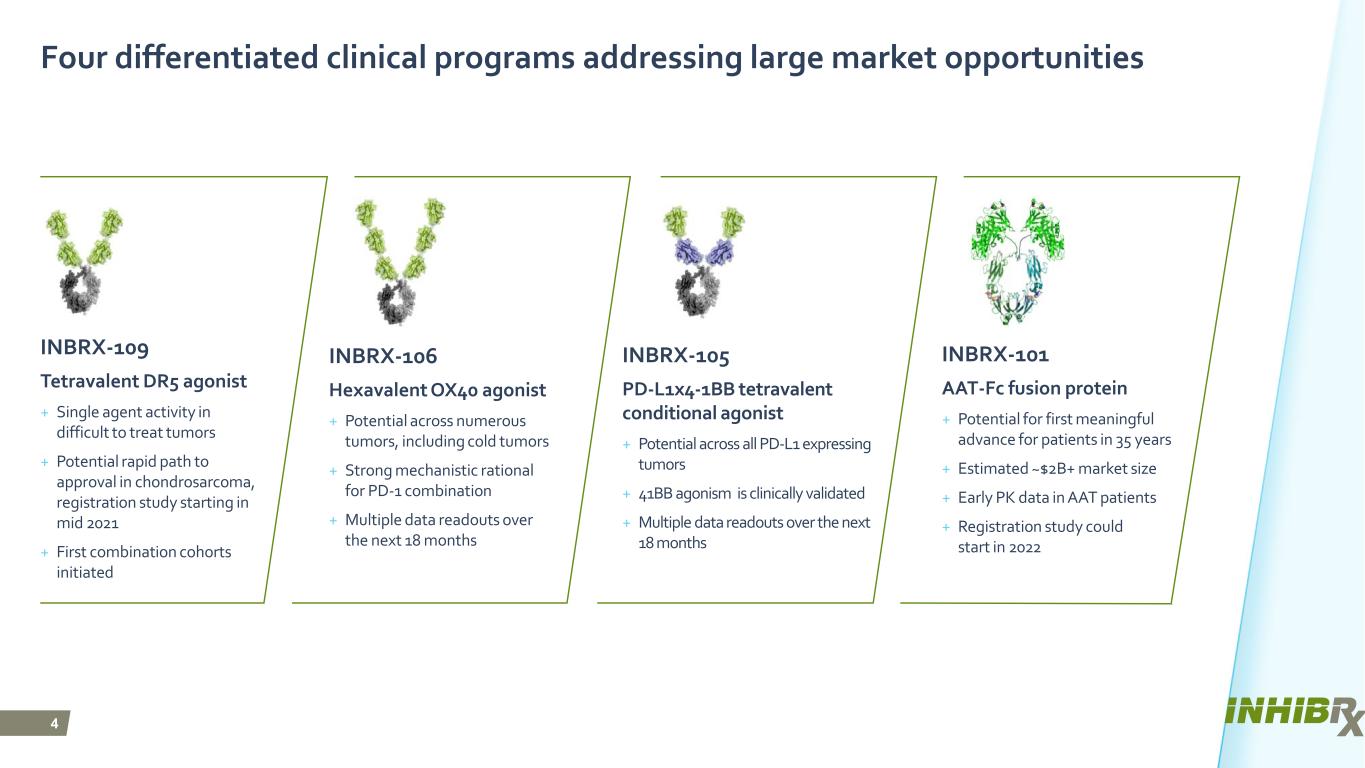
4 Four differentiated clinical programs addressing large market opportunities INBRX-109 Tetravalent DR5 agonist + Single agent activity in difficult to treat tumors + Potential rapid path to approval in chondrosarcoma, registration study starting in mid 2021 + First combination cohorts initiated INBRX-106 Hexavalent OX40 agonist + Potential across numerous tumors, including cold tumors + Strong mechanistic rational for PD-1 combination + Multiple data readouts over the next 18 months INBRX-105 PD-L1x4-1BB tetravalent conditional agonist + Potential across all PD-L1 expressing tumors + 41BB agonism is clinically validated + Multiple data readouts over the next 18 months !" INBRX-101 AAT-Fc fusion protein + Potential for first meaningful advance for patients in 35 years + Estimated ~$2B+ market size + Early PK data in AAT patients + Registration study could start in 2022

5 Inhibrx’s modular sdAb platform 75 kDa 90 kDa 105 kDa 120 kDa 135 kDa 75 kDa 90 kDa 105 kDa 120 kDa 135 kDa Inhibrx multivalent formats Inhibrx multispecific formats Precision engineering Readily manufactured at high yields using standard processes Versatile and innovative formats enable validated complex target biology to be exploited – Multivalent – precise valency selection engineered to specific target biology – Multispecific – engineered for optimal synergistic or co-dependent functionalities – Smaller than conventional antibodies

INBRX-109 Tetravalent DR5 Agonist

7 Death receptor 5 target overview Death receptor 5 (DR5) is a receptor for the tumor necrosis factor-related apoptosis-inducing ligand (TRAIL) DR5 activation naturally eliminates damaged and neoplastic cells Higher order clustering of DR5 is required to drive signaling Potential to treat cancers that are unresponsive to immunotherapy DR5 requires the right valency to trigger apoptosis of cancer cells and spare healthy cells A p o p to si s V al en cy 2 4 >4 healthy cancer healthy cancer healthy cancer

8 Valency drives DR5-mediated apoptosis INBRX-109 is 100x more potent in preclinical assays compared to first generation bivalent and trivalent agonists Impact of valency on DR5 induced tumor cell death 1 10 25 50 75 100 % V ia bi lit y 0 Concentration (nM) 10-110-210-310-410-5 TRAIL (Trivalent) INBRX-109 (Tetravalent) Anti-DR5 mAb (Bivalent) Weak Antibody DR5 INBRX-109 Tetravalent Strong DR5 TRAIL DR5 Moderate Apoptosis healthy cancer healthy cancer healthy cancer
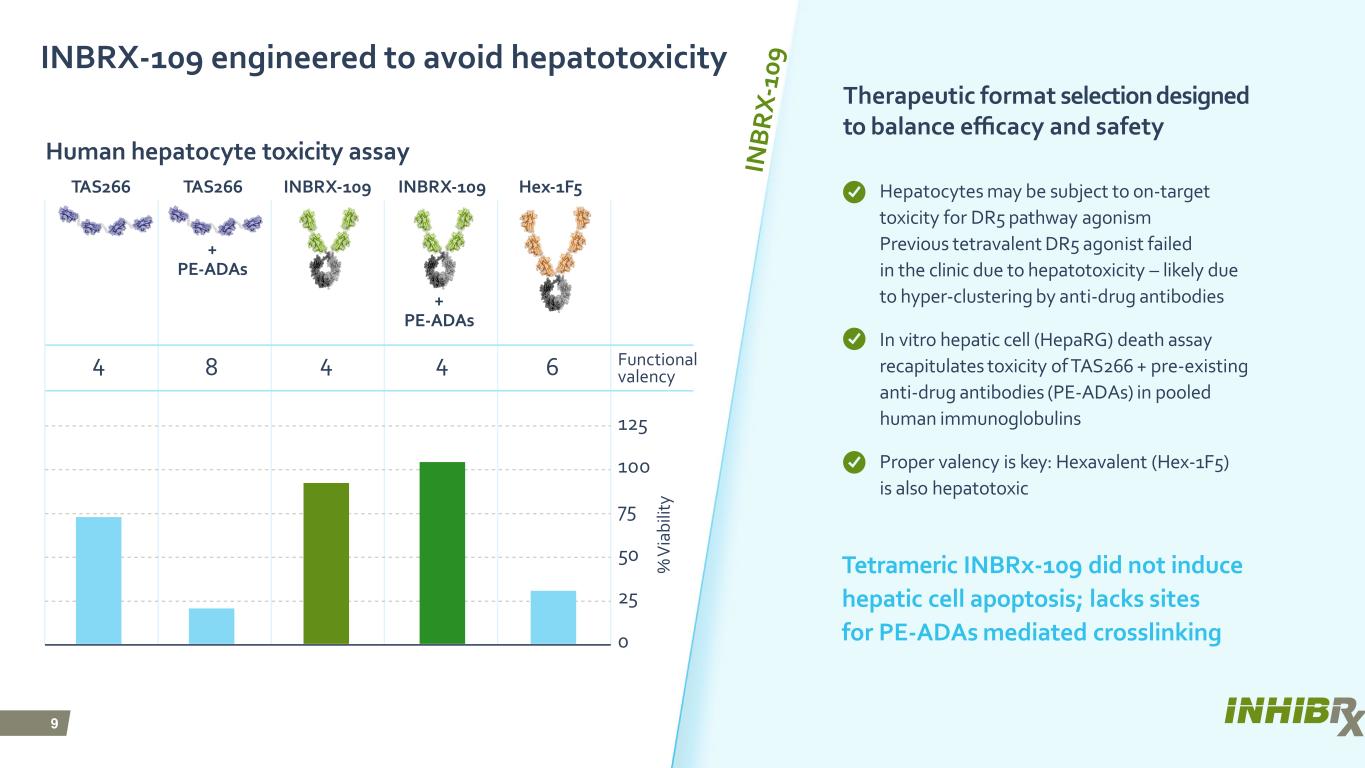
9 INBRX-109 engineered to avoid hepatotoxicity Tetrameric INBRx-109 did not induce hepatic cell apoptosis; lacks sites for PE-ADAs mediated crosslinking Human hepatocyte toxicity assay Hepatocytes may be subject to on-target toxicity for DR5 pathway agonism Previous tetravalent DR5 agonist failed in the clinic due to hepatotoxicity – likely due to hyper-clustering by anti-drug antibodies In vitro hepatic cell (HepaRG) death assay recapitulates toxicity of TAS266 + pre-existing anti-drug antibodies (PE-ADAs) in pooled human immunoglobulins Proper valency is key: Hexavalent (Hex-1F5) is also hepatotoxic Therapeutic format selection designed to balance efficacy and safety 125 100 75 50 25 0 TAS266 TAS266 INBRX-109 Hex-1F5 + PE-ADAs INBRX-109 + PE-ADAs 4 8 4 4 6 Functionalvalency % V ia bi lit y

10 Ph1 INBRX-109 trial design and status Chondrosarcoma Synovial sarcoma Colorectal adenocarcinoma 20 PART 2: Dose expansion cohorts Initial expansion cohort indications were selected based on in vitro and in vivo sensitivities to the DR5 pathway and clinical data from prior DR5 agonists PART 3: Combination studies Investigation of a predictive biomarker of pathway sensitivity is ongoing ongoing Malignant pleural mesothelioma 10 20 20 PART 1: Dose escalation 0.3 to 30 mg/kg N=20 Result: MTD not reached completed Aug. 2019 First in human Phase 1 trial started Nov. 2018 initiated Pancreatic adenocarcinoma 2nd line with FOLFIRI Mesothelioma with Cis-/Carboplatin & Pemetrexed 20 20 Gastric adenocarcinoma 10

11 Therapeutic IPI-926 (HH) Control arm Placebo Subject number 100 (2:1) Efficacy data PFS 3.7 mo vs 2.9 mo Placebo Comment Negative study Fast to market opportunity ~1,400 cases per year Incidence rate of ~1 in 200,000 persons per year USA Worldwide Chondrosarcoma PFS from failed study *The figures on this slide represent market research estimates. No approved therapeutic for the treatment of chondrosarcoma
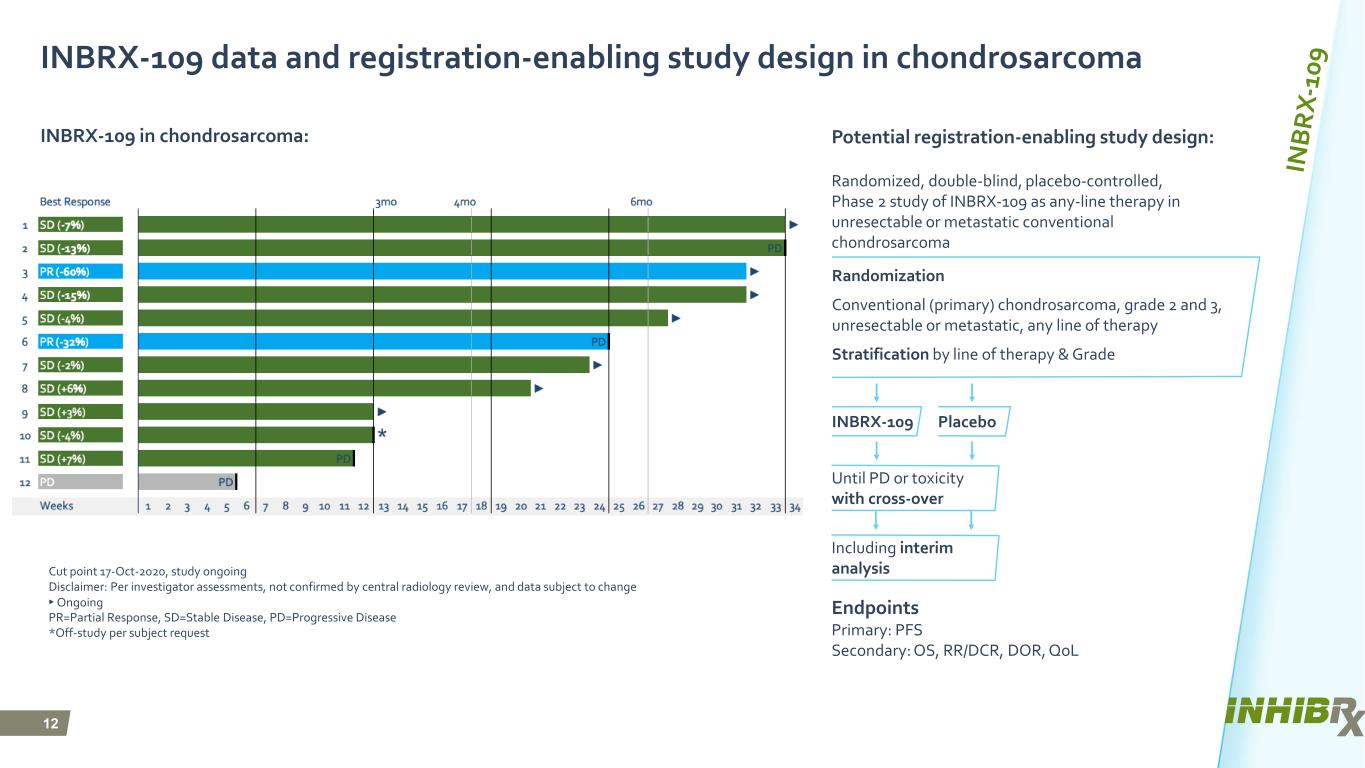
12 INBRX-109 data and registration-enabling study design in chondrosarcoma INBRX-109 in chondrosarcoma: Cut point 17-Oct-2020, study ongoing Disclaimer: Per investigator assessments, not confirmed by central radiology review, and data subject to change ► Ongoing PR=Partial Response, SD=Stable Disease, PD=Progressive Disease *Off-study per subject request Randomized, double-blind, placebo-controlled, Phase 2 study of INBRX-109 as any-line therapy in unresectable or metastatic conventional chondrosarcoma Endpoints Primary: PFS Secondary: OS, RR/DCR, DOR, QoL INBRX-109 Placebo Until PD or toxicity with cross-over Randomization Conventional (primary) chondrosarcoma, grade 2 and 3, unresectable or metastatic, any line of therapy Stratification by line of therapy & Grade Potential registration-enabling study design: Including interim analysis

13 INBRX-109 potential in multiple indications INITIAL INDICATIONS STUDIES INITIATED IN Q3 OF 2020 FUTURE POTENTIAL OPPORTUNITIES Mesothelioma Chemotherapy combination or single agent Pancreatic – 2nd line FOLFIRI Mesothelioma Cis-/Carboplatin & Pemetrexed Synovial sarcoma Solid tumors + IAP antagonists Hematologic tumors + Bcl-2 inhibitors NSCLC + various combo agents Gastric and colon cancer + various combo agents Additional sarcoma indications Chondrosarcoma Registration-enabling study in planning stage as single agent

INBRX-106 Hexavalent OX40 Agonist

15 INBRX-106 hexavalent OX40 agonist OX40 is a co-stimulatory receptor on activated T-cells Hexavalent engagement of OX40: • Provides co-stimulation to activated T-cells • Reverses regulatory T-cell induced immune suppression • Enhances T-cell functionality; additional benefit in combination with PD-1 blockade Signs of activity at low doses observed in Phase 1 in multiple patients, including cold tumors and prior PD-1 failures OX40: sdAb OX40: sdAb OX40: sdAb OX40: sdAb 129kDa OX40: sdAb Fc OX40: sdAb
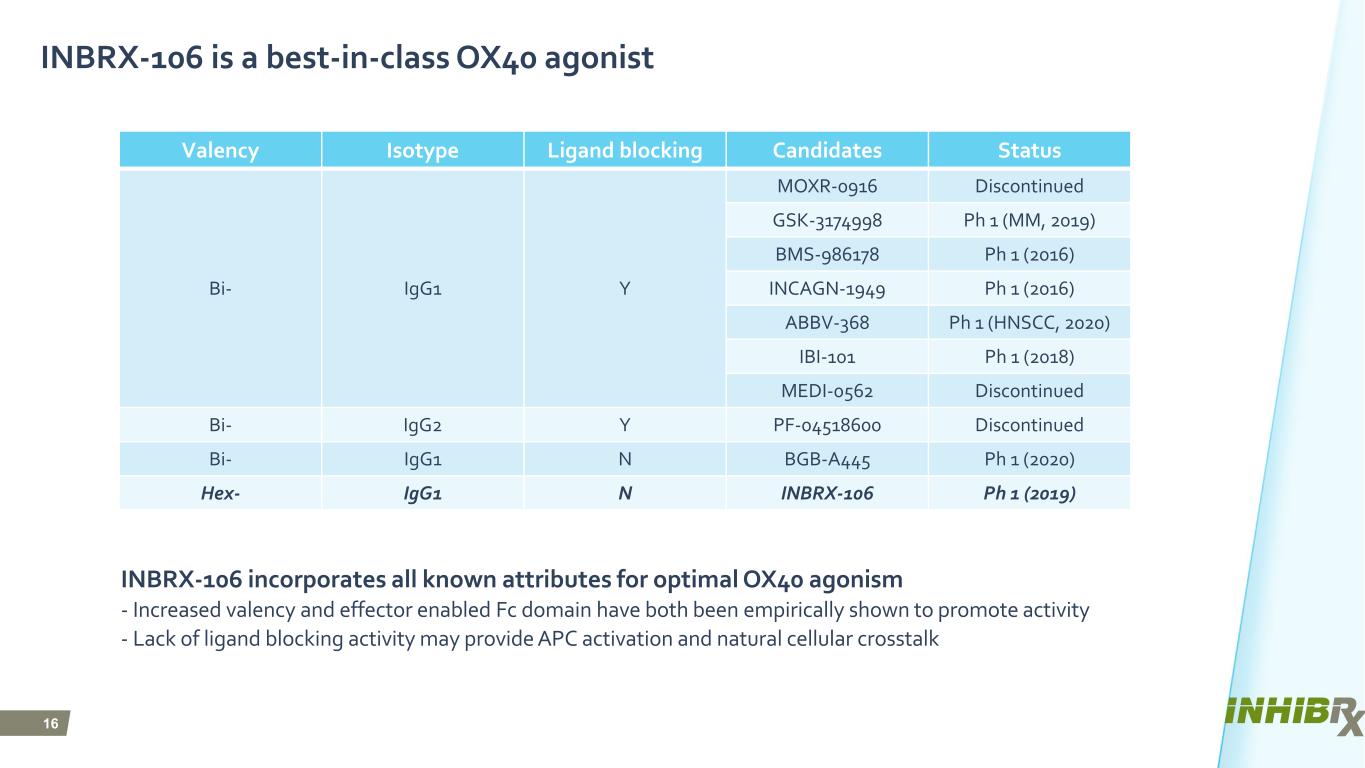
16 INBRX-106 is a best-in-class OX40 agonist INBRX-106 incorporates all known attributes for optimal OX40 agonism - Increased valency and effector enabled Fc domain have both been empirically shown to promote activity - Lack of ligand blocking activity may provide APC activation and natural cellular crosstalk Valency Isotype Ligand blocking Candidates Status Bi- IgG1 Y MOXR-0916 Discontinued GSK-3174998 Ph 1 (MM, 2019) BMS-986178 Ph 1 (2016) INCAGN-1949 Ph 1 (2016) ABBV-368 Ph 1 (HNSCC, 2020) IBI-101 Ph 1 (2018) MEDI-0562 Discontinued Bi- IgG2 Y PF-04518600 Discontinued Bi- IgG1 N BGB-A445 Ph 1 (2020) Hex- IgG1 N INBRX-106 Ph 1 (2019)
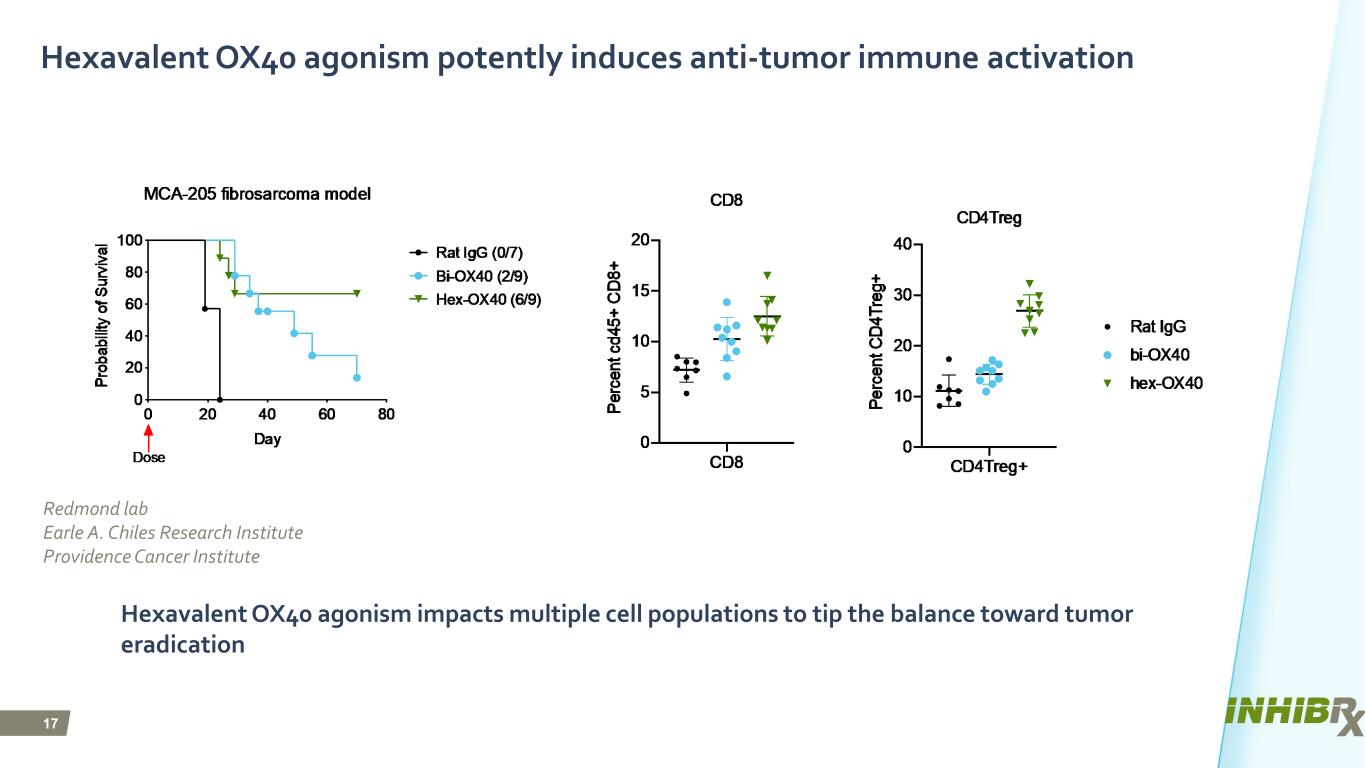
17 Hexavalent OX40 agonism potently induces anti-tumor immune activation Hexavalent OX40 agonism impacts multiple cell populations to tip the balance toward tumor eradication Redmond lab Earle A. Chiles Research Institute Providence Cancer Institute

18 Phase 1 INBRX-106 trial design and status Initial data from Part 1 PARTS 2 & 4: Expansion cohorts INBRX-106 (Multiple dosing schedules) PARTS 1 & 3: Dose escalation finished Dec 2020 - Dose escalation in combination with Keytruda™ initiated - Signs of single agent activity, including prior PD-1 failures - 0.03 mg/kg dose selected based on rapid loss of OX40, memory T cell activation and proliferation, and sufficient drug clearance to allow target recovery - Part 2 initiated Single agent: PD-L1+ Basket INBRX-106 + Keytruda™ (post PD-1/ PD-L1 CPI) Combo: PD-L1+ NSCLC and PD-L1+ Basket *Ongoing Data cut point January 4, 2021 Dose Level (mg/kg) Demographics Tumor Type Notable Prior Therapies, Best Response and Duration Best Response RECISTv1.1 Duration (weeks) 0.0003-0.003 59 M W Small intestine cancer (GIST) Imatinib PR, Sunitinib UK, Regorafenib UK, Nilotinib UK, Imatinib UK, Pazopanib UK, APG-115 (MDM2) SD 3mo, CX-2029 (CD71 ADC) PD 2mo SD (+2%) 33 0.001-0.01 85 F W Melanoma (cutaneous) Pembrolizumab SD 3.5y SD (-23%) 40 0.003-0.01 69 M W Bladder Ca Cis/Gem PD 4mo, Nivolumab PD 5m0 PD 6 0.01-0.1 56 F Other NSCLC, AD(PD-L1 TPS 40%) Carbo/Pemetrexed/Pembrolizumab PD 2mo SD (not measurable) 42* 0.03-0.1 54 M W Esophageal AD FOLFOX UK 4mo PD 6 0.1 55 M W Esophageal AD Carbo/Taxol NE, Pembrolizumab PD 3mo,FOLFOX PR 4mo, Taxol/Ramucirumab PD 1mo SD (+12%) 12 0.1 78 M W Prostate AD (CRPC) Docetaxel UK 4mo, ADT, Enzalutamide UK, Abiraterone UK, Cabazitaxel UK 2mo, SMO08502 (CLK2/3 SMI) SD 9mo SD (+6%, PSA -52%) 18 0.1 58 F W Renal Cell Ca (sarcomatoid) Gemcitabine, Sunitinib, Nivolumab SD 12mo,CabozantinibUK 3mo, BMS-986258 & Nivolumab SD 2mo PD 5

INBRX-105 PD-L1 x 4-1BB Multispecific
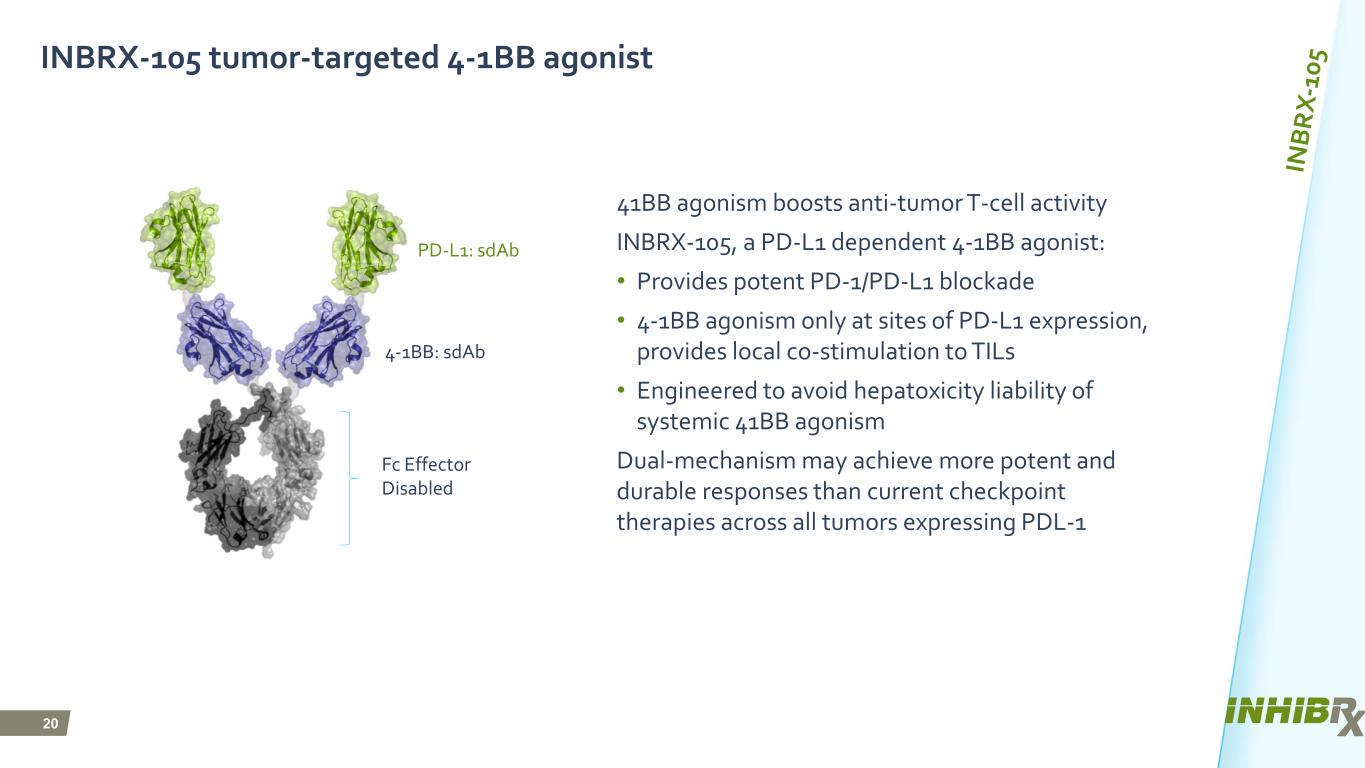
20 INBRX-105 tumor-targeted 4-1BB agonist 41BB agonism boosts anti-tumor T-cell activity INBRX-105, a PD-L1 dependent 4-1BB agonist: • Provides potent PD-1/PD-L1 blockade • 4-1BB agonism only at sites of PD-L1 expression, provides local co-stimulation to TILs • Engineered to avoid hepatoxicity liability of systemic 41BB agonism Dual-mechanism may achieve more potent and durable responses than current checkpoint therapies across all tumors expressing PDL-1 PD-L1: sdAb 4-1BB: sdAb Fc Effector Disabled

21 INBRX-105 reversed suppression by PD-L1 *synthesized from sequences disclosed in WO 2018/056821 MCLA-145 analog* displayed ~20 fold reduction in potency Data indicated potential advantage of bivalent PD-L1 binding and blockade INBRX-105 potently reversed PD-L1/PD-1 suppression with activity equivalent to Tecentriq® in preclinical assay Cell based PD-1/PD-L1 blockade assay: artificial antigen presenting cells expressing PD-L1 and TCR-agonist co-cultured with TCR+ reporter cells PD-1/PD-L1 Blockade Reporter Assay Antibody [nM] 110-110-210-310-4 P D L- L1 B lo ck ad e (R LU ) 150,000 100,000 50,000 101 102 Tecentriq INBRX-105 MCLA-145 Analog Anti-PD-L1 Anti-PD-L1 Tecentriq PD-L1 mAb Analog: Merus MCLA-145 PD-L1 × 41BB Anti-PD-L1 Anti-4-1BB INBRX-105 PD-L1 × 41BB PD-L1 sdAb PD-L1 sdAb 4-1BB sdAb 4-1BB sdAb

22 Phase 1 INBRX-105 trial design and status First in human Phase 1 trial started Feb. 2019 PART 1: Dose escalation INBRX-105 ongoing Locally advanced or metastatic solid tumors PDL1+ NSCLC PDL1+ Melanoma PDL1+ Basket PART 4: Dose expansion INBRX-105 + Keytruda™ planned N=20 N=20 N=20 80 patient combination expansion cohort, indications selected based on known sensitivity to 4-1BB and checkpoint blockade PART 3: Dose escalation INBRX-105 + Keytruda™ planned PDL1+ NSCLC PDL1+ Melanoma PART 2: Dose expansion INBRX 105 planned N=8 N=8 24 patient single agent expansion cohort, indications selected based on known sensitivity to 4-1BB and checkpoint blockade PDL1+ BasketN=8 Locally advanced or metastatic solid tumors PDL1+, CPI naïve (Tumor type TBD) N=20

INBRX-101 Recombinant Alpha-1 Antitrypsin Fc-fusion Protein

24 AATD and current therapy shortcomings AAT Serum levels in patients receiving weekly pdAAT Opportunity: The global AATD augmentation therapy market size was valued at $1.1B annually in 2018 and projected to reach $1.9B by the end of 2026 What is AATD? AATD is an orphan respiratory inherited disease Increases risk of developing pulmonary disease, resulting in progressive loss of lung function and decreased life expectancy Small percentage of patients also develop liver disease AATD standard of care Current therapy is sub-optimal Plasma derived AAT with weekly infusions is not able to maintain normal serum AAT levels Weekly dosing is inconvenient, longer AAT half-life needed Market size is >$1.1B annually and growing 60 M ea n Se ru m A AT le ve l ( μM ) 40 20 0 0 7 14 21 28 Day Normal AAT serum range (20 - 50 μM) Below normal AAT serum range (<20 μM) Dosing

25 INBRX-101 optimizing AAT augmentation therapy AAT Half life extension mutations Elimination of oxidation-prone residues Fc INBRX-101 is a precisely engineered recombinant human AAT-Fc fusion protein • Potential to extend the dosing range, from weekly to every three weeks, while maintaining patients in the normal range of AAT exposure • Overcame challenges of maintaining function of recombinant AAT while manufacturing at commercial scale • Engineered to maximize the functional activity of AAT, particularly in the lung

26 INBRX-101: first human pharmacokinetic data PK profile of first 5 patients: 10 mg/kg INBRX-101 Predicted mean serum AAT levels: 120 mg/kg of INBRX-101 every 3 weeks Preliminary human PK data for first five subjects dosed with 10 mg/kg single IV dose of INBRX-101 • Consistent with preclinical estimates • Estimated human half-life is approximately 13 days *Data from these subjects needs to be confirmed with additional subjects and higher doses *Half-life estimate based on N = 3 subjects with sufficient PK sampling Functional AAT levels achieved with INBRX-101 (120 mg/kg IV q21d) are predicted to have improved exposure vs. published data for pdAAT (60 mg/kg IV q7d) • Modeling predicts a dose of 120 mg/kg q21d should meet the goal of maintaining normal range (> 20 μM) Phase 1 clinical data expected in H2 2021 10 Se ru m A A T le ve l ( μ M ) Time (Days) 0 M ea n se ru m A A T le ve l ( μ M ) 1 0,1 7 14 21 28 Time (Days) 0 21 42 63 84 105 Normal AAT serum range (20–50 μM) Predicted INBRX-101 AAT concentrations Published once weekly pdAAT mean AAT concentrations 100 10 1

27 H2 2020 H1 2021 H2 2021 Near term expected clinical milestones INBRX-109 (DR5) registration-enabling trial initiation- chondrosarcoma INBRX-101 (AAT) Phase 1 data INBRX-105 (PDL-1x41BB) dose escalation data INBRX-105 (PDL-1x41BB) expansion cohort data INBRX-109 (DR5) Chondrosarcoma updated data at CTOS INBRX-106 (OX40) monotherapy dose escalation cohort data INBRX-109 (DR5) initial combination study data INBRX-106 (OX40) / Keytruda dose escalation cohort data

11025 N. Torrey Pines Rd, Ste 140 La Jolla, CA 92037 www.inhibrx.com

Supplementary Slides

30 INBRX-109 data in malignant pleural mesothelioma Cut point 17-Oct-2020, study ongoing Disclaimer: Per investigator assessments, not confirmed by central radiology review, and data subject to change PR=Partial Response, SD=Stable Disease, PD=Progressive Disease, NE=Not Evaluable ► Ongoing *Off-study per subject request

31 INBRX-109 - favorable Adverse Event (AE) profile AE Term AE related to INBRX-109 (very likely, probable, possible) Grade per CTCAEv5.0 Gr1&2 (N) Gr1&2 (%) Gr=/>3 (N) Gr=/>3 (%) All Grade (N) All Grade (%) Fatigue 14 18 0 0 14 18 AST increased 7 9 3 4 10 13 ALT increased 7 9 3 4 10 13 Nausea 6 8 1 1 7 9 Pyrexia 5 7 0 0 5 7 Diarrhea 4 5 0 0 4 5 Data cut point 2-Aug-2020 Disclaimers: • Total subjects 76, study ongoing • AE ≥ 4 • Relationship to INBRX-109 per Investigator assessments • Preliminary data (Raw, unvalidated, not QC) • Excluded data: Uncoded AE; missing AE terms; missing causality; missing severity One death possibly attributed to study drug, acute hepatic failure in patient with mesothelioma (N=1/76,1.3%)
